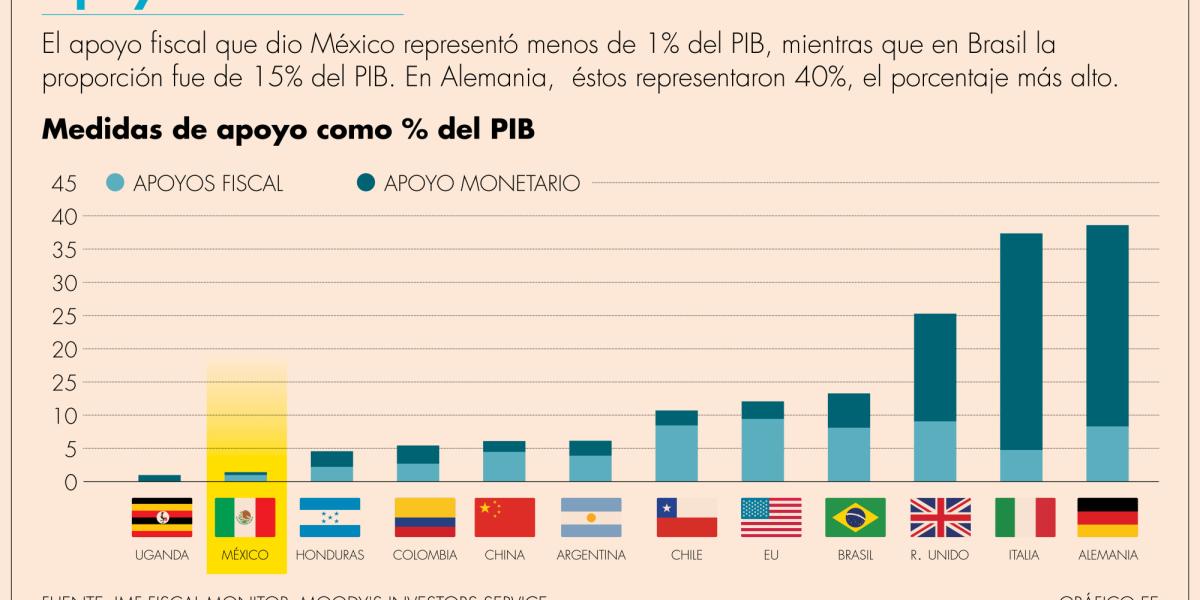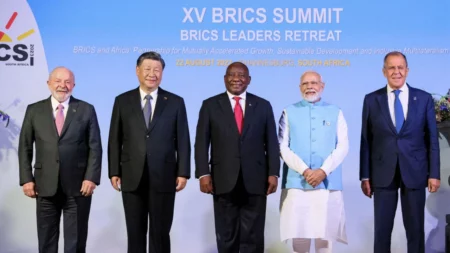Mexico and Uganda have the most modest fiscal stimulus in response to pandemic: Institute of International Finance

Mexico and Uganda were the countries that provided the least amount of countercyclical stimulus to try to limit the impact of the closure of economic activities due to the pandemic in 2020, according to Monetary Fund (IMF) figures released by the International Institute of Finance in a report. analysis.
In a sample of 84 countries, published by Moody's, it was noted that while Uganda and Mexico gave less than one point of GDP in fiscal stimulus strategies, countries such as Germany and Italy gave support of nearly 40% of GDP.
When approaching the stimulus provided by emerging economies, the African Government of the Republic of Mauritius provided the strongest support, approximately 35% of GDP, and the Czech Republic, which provided the equivalent of 20% of GDP. Domestic Demand Stimulation Strategy
If the data is rounded in terms of regions, Peru and Brazil are the Latin American countries that directed the largest stimulus in the region, amounting to 15% of GDP.
Pressure on businesses and homes in Mexico
Analysts from the rating agency Moody's, in a report on frequently asked questions asked by investors and clients, highlighted that “Mexico's non-aggressive fiscal response (…) generated pressures on companies and households and did not clearly contribute to containing the economic impact of the pandemic.”
Moody's analysts believe that “in the absence of financial support from the Mexican government, income and employment levels will continue to deteriorate, with small businesses continuing to go bankrupt.”
“Business bankruptcies will continue to affect domestic demand and the possibility of a rapid recovery, as they will leave a deep scar on the Mexican economy,” they warned.
Room to maneuver
In a separate analysis, led by IIF Deputy Chief Economist Sergi Lanao, they explained that Mexico, along with India, South Africa and Turkey, “have not spent much on expansionary policy and it may be difficult for them to come back.” to pre-financial crisis levels.
After reviewing a historical database of large spending increases covering more than 100 episodes, IIF experts identified that very few countries reduced spending entirely in the five years following a large increase.
However, they noted that “the few countries that were able to stabilize their public finances did so within a year of incurring a deficit, and almost always in conjunction with economic recovery.”
Given past experience, controlling the fiscal deficit will be particularly difficult in countries such as Argentina and Brazil, where spending increased sharply last year. At the other end of the spectrum, India and Mexico stood out for providing minimal fiscal support, which was not good for growth.
Financial stress, post-mortem
However, IIF experts explained that this moderate fiscal stimulus “could limit the risks of future policy errors.”
The analysis, titled Fiscal Deficits in Emerging Markets, said: “Although fiscal deficits in emerging markets rose to record levels last year, most countries responded to the impact of Covid-19 by significantly directing spending, and markets have welcomed expansionary policies.” “Well.”
They added: “Economic recovery will increase tax revenues and the deficit can be reduced.” This will be the case as economies recover, as a result of fiscal stimulus.
“Many countries launched aggressive fiscal measures, taking advantage of the space available to them,” Barclays head of economic research for Latin America, Marco Oviedo, explained in December. “Some may not have had much space and were still calling for stimulus.”
“The challenge now is to adapt, because fiscal stimulus has a cost, it hurts, and they have to present credible plans, and this is where a little bit of risk has been placed on fiscal credibility,” he commented.
He stressed that it is not yet possible to know whether it would be better to grant large financial incentives, such as those applied by Brazil or Peru. “We will have an autopsy of all these measures in the coming months, to evaluate how successful they were in activity and employment,” he said, taking as an example the case of Brazil, “which implemented a brutal fiscal program of 4 or 5 points of GDP, but its employment did not recover as quickly.” Mexico recovered.

“Award-winning zombie scholar. Music practitioner. Food expert. Troublemaker.”









